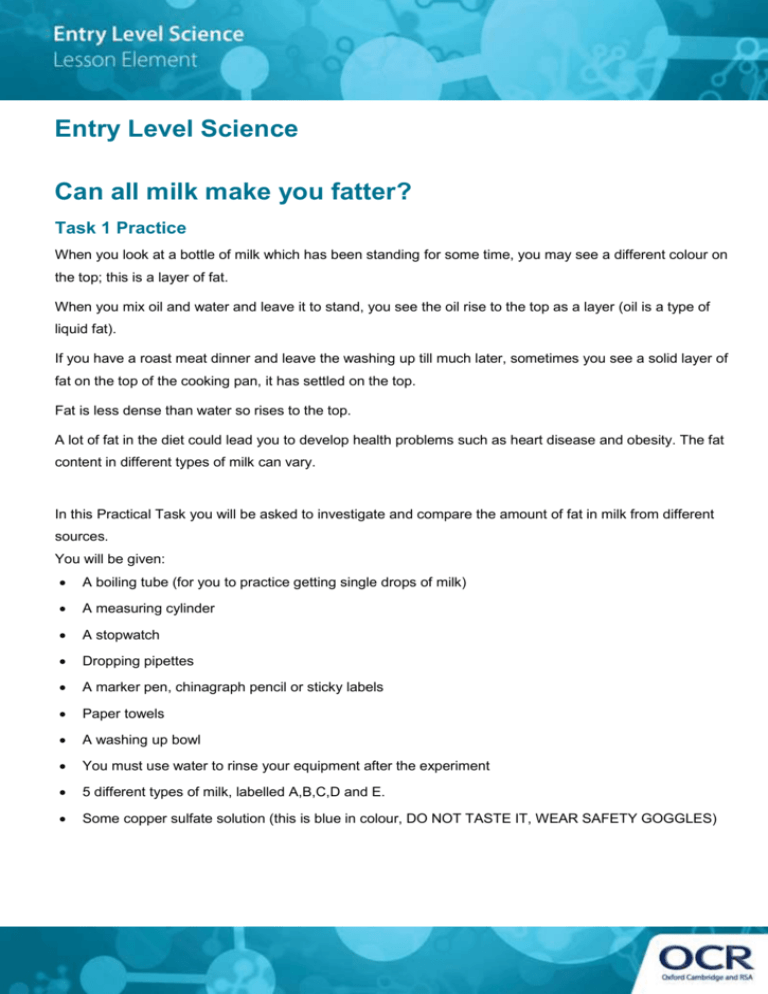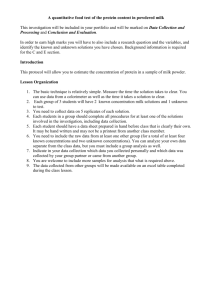Can all milk make you fatter?
advertisement

Entry Level Science Can all milk make you fatter? Task 1 Practice When you look at a bottle of milk which has been standing for some time, you may see a different colour on the top; this is a layer of fat. When you mix oil and water and leave it to stand, you see the oil rise to the top as a layer (oil is a type of liquid fat). If you have a roast meat dinner and leave the washing up till much later, sometimes you see a solid layer of fat on the top of the cooking pan, it has settled on the top. Fat is less dense than water so rises to the top. A lot of fat in the diet could lead you to develop health problems such as heart disease and obesity. The fat content in different types of milk can vary. In this Practical Task you will be asked to investigate and compare the amount of fat in milk from different sources. You will be given: A boiling tube (for you to practice getting single drops of milk) A measuring cylinder A stopwatch Dropping pipettes A marker pen, chinagraph pencil or sticky labels Paper towels A washing up bowl You must use water to rinse your equipment after the experiment 5 different types of milk, labelled A,B,C,D and E. Some copper sulfate solution (this is blue in colour, DO NOT TASTE IT, WEAR SAFETY GOGGLES) What you do Your teacher will show you what you are going to do. Your teacher will give you some milk. Look at the diagram of the apparatus. dropping pipette containing milk 250cm3 glass measuring cylinder 0.1M Copper II Sulfate solution Collect the apparatus. First, pour some copper sulfate solution into a boiling tube. With a dropping pipette take a little of one of the types of milk. If you release a single drop onto the top of the copper sulfate solution you will see it slowly fall to the bottom of the tube. You may need to practice this several times to get it done well as you MUST only use 1 drop. When you are happy with the way you are able to release a drop of milk, ask your teacher for the Practical Task instruction sheet. Task 2 Practical Task Your teacher will show you how to do the practical. You need to practice it until you are happy (see Task 1). Carry out the method below. Look at the diagram to help you set the apparatus up correctly. You need to follow the instructions carefully. dropping pipette containing milk 250cm3 glass measuring cylinder 0.1M Copper II Sulfate solution Collect all the equipment you need. Make sure you have safety goggles when using the copper sulfate solution. Fill the measuring cylinder to the 250 cm3 mark with copper sulfate solution. Use a marker pen, or sticky labels to identify the 200 cm3 and 100 cm3 mark. Stir some of milk with a glass rod. Make a note of what type of milk you are using. Suck up a little of the milk into a dropping pipette. Carefully hold the tip of the syringe just above the top of the copper sulfate solution. Look at the diagram to help you. Allow 1 drop of milk from the pipette. It will begin to fall through the solution. (If you make a mistake you will need to start again and make another drop, but you should have practiced this a lot.) Start the stopwatch when the drop reaches the 200 cm3 mark and stop it when the drop reaches the 100 cm3 mark. Put your time in the results table. Repeat this with the same milk at least three times. Repeat with all the other milk samples you have been given. Fill in your results in the table. Put the units of time in yourself. Type of milk Time for milk to drop - attempt 1 ( ) Task 3 Practical Write Up Title of my Investigation What I did: Time for milk to drop - attempt 2 ( ) Time for milk to drop - attempt 3 ( ) Average time for milk to drop ( ) What equipment I used: How I made my investigation safe: My results table (don’t forget, units, headings, repeats and work out an average for the time it took the drop to fall for each milk you used): Draw a graph or chart to show how long it takes for each type of milk drop to fall. Don’t forget a title and labels on your axes. Can you notice any pattern in your results? Try to make an ‘er…er’ statement about it. (Hint, look at the labels on the milk to see the ‘fat content’) Can you think of any scientific reason why you got these results? If you can, write it here. If you can’t try to think what your results might mean? Can you make a comment about your experiment. Try to say how you carried out the experiment and how it affected your results.







